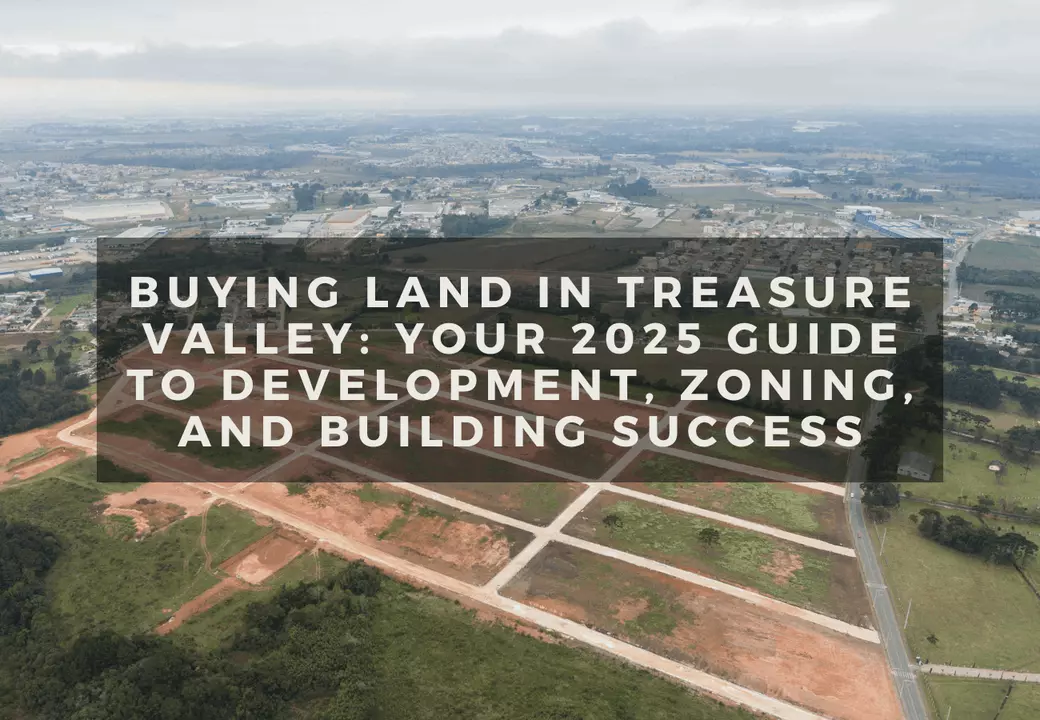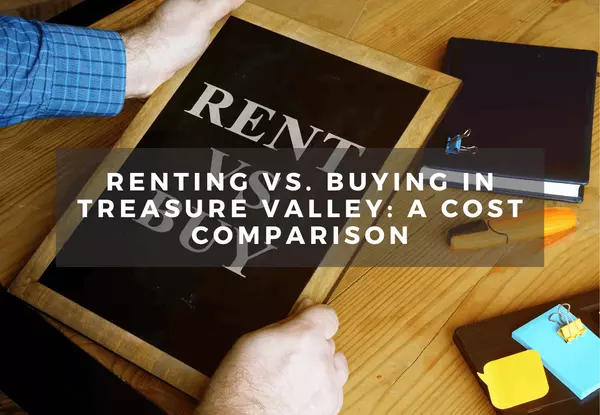Buying Land in Treasure Valley: Your 2025 Guide to Development, Zoning, and Building Success

Your Roadmap to Building on Land in Idaho’s Treasure Valley
In 2025, the Treasure Valley continues to attract those seeking to build custom homes or invest in land. With its blend of urban amenities and rural charm, areas like Boise, Meridian, Nampa, and Eagle offer diverse opportunities. However, purchasing land and embarking on a construction project here involves navigating zoning laws, utility access, and construction planning. This guide provides a comprehensive overview to help you make informed decisions.
Step 1: Define Your Vision and Budget
Clarify Your Intentions
Before searching for land, determine your objectives:
-
Primary Residence: Building your dream home.
-
Investment: Developing rental properties or subdividing land.
-
Agricultural Use: Farming or ranching activities.
-
Recreational Use: Creating a personal retreat or vacation property.
Establish a Realistic Budget
Consider all costs associated with land development:
-
Land Purchase Price: Varies based on location and size.
-
Site Preparation: Clearing, grading, and soil testing.
-
Utility Connections: Water, sewer, electricity, and internet access.
-
Permits and Fees: Building permits, impact fees, and inspections.
-
Construction Costs: Materials, labor, and contractor fees.
-
Contingency Fund: Allocate at least 10-15% for unforeseen expenses.
Step 2: Choose the Right Location
Evaluate Communities
Each area in the Treasure Valley offers unique advantages:
-
Boise: Urban amenities with a vibrant cultural scene.
-
Meridian: Family-friendly neighborhoods and schools.
-
Nampa: Affordable land with a growing community.
-
Eagle: Upscale living with scenic views.
Assess Accessibility and Amenities
Consider proximity to:
-
Workplaces and Schools: Commute times and educational institutions.
-
Healthcare Facilities: Hospitals and clinics.
-
Shopping and Recreation: Stores, restaurants, parks, and entertainment.
Step 3: Understand Zoning and Land Use Regulations
Identify Zoning Classifications
Zoning dictates permissible land uses:
-
Residential (R): Single-family or multi-family dwellings.
-
Commercial (C): Retail, offices, and services.
-
Industrial (I): Manufacturing and warehouses.
-
Agricultural (A): Farming and livestock.
Consult local zoning maps and ordinances to verify land use compatibility.
Check for Restrictions and Overlays
Be aware of additional regulations:
-
Setback Requirements: Minimum distances from property lines.
-
Height Limits: Maximum building heights.
-
Environmental Protections: Wetlands, flood zones, or wildlife habitats.
-
Historic Districts: Preservation guidelines for certain areas.
Step 4: Conduct Thorough Due Diligence
Perform a Title Search
Ensure clear ownership and identify any:
-
Liens: Outstanding debts secured by the property.
-
Easements: Rights granted to others to use part of the land.
-
Encroachments: Structures extending onto the property.
Obtain a Land Survey
A professional survey will:
-
Define Boundaries: Accurate property lines.
-
Identify Topography: Elevation changes and natural features.
-
Locate Utilities: Existing infrastructure and access points.
Assess Environmental Conditions
Evaluate factors that may impact development:
-
Soil Quality: Suitability for construction and septic systems.
-
Water Table: Depth and stability for wells or basements.
-
Flood Risk: Potential for water damage and insurance requirements.
Step 5: Plan for Utilities and Infrastructure
Determine Utility Availability
Identify access to:
-
Water Supply: Municipal connections or private wells.
-
Sewage Disposal: City sewer systems or septic tanks.
-
Electricity and Gas: Service providers and connection fees.
-
Internet and Phone: Availability of high-speed options.
Consider Road Access
Ensure legal and practical access to your property:
-
Public Roads: Maintained by local authorities.
-
Private Roads: Shared maintenance responsibilities.
-
Easements: Legal rights to cross adjacent properties.
Step 6: Secure Financing and Insurance
Explore Financing Options
Land loans differ from traditional mortgages:
-
Higher Down Payments: Often 20-50% due to increased risk.
-
Shorter Terms: Typically 5-15 years.
-
Interest Rates: Generally higher than home loans.
Consult with lenders experienced in land purchases to find suitable options.
Obtain Appropriate Insurance
Protect your investment with:
-
Title Insurance: Covers ownership disputes.
-
Liability Insurance: Protects against accidents on the property.
-
Builder’s Risk Insurance: Covers construction-related damages.
Step 7: Navigate the Building Process
Design Your Home
Work with architects and designers to:
-
Develop Plans: Reflecting your needs and preferences.
-
Ensure Compliance: Adhering to zoning and building codes.
-
Optimize Site Use: Considering sunlight, views, and topography.
Obtain Necessary Permits
Submit applications for:
-
Building Permits: Authorizing construction activities.
-
Septic or Sewer Permits: For waste disposal systems.
-
Electrical and Plumbing Permits: For utility installations.
Coordinate with local planning departments to ensure all requirements are met.
Hire Qualified Contractors
Select professionals with experience in:
-
Local Building Practices: Familiarity with regional codes and conditions.
-
Project Management: Coordinating timelines and subcontractors.
-
Quality Assurance: Delivering craftsmanship and reliability.
Conclusion: Building Your Future in Treasure Valley
Purchasing land and constructing a home in the Treasure Valley is a rewarding endeavor that requires careful planning and due diligence. By understanding zoning laws, conducting thorough research,
you’ll be equipped to make confident decisions and avoid costly surprises. Whether you're crafting a personal sanctuary, launching a smart investment project, or laying the foundation for a multigenerational legacy, the Treasure Valley offers a rich landscape of opportunity.
But here’s the key: The success of your build doesn’t start with a hammer—it starts with the homework. Zoning regulations, utility access, permitting, and team selection are the groundwork that set your project up for success. Don’t skip those steps, because while buying land is exciting, it’s what you do next that determines whether it becomes a dream home—or a financial headache.
And if you're navigating this process from out of state, you don’t have to go it alone. I help buyers just like you every week—some relocating to Idaho, others investing from afar—make sense of the terrain, evaluate smart land buys, and align the right builder relationships to get it done. Let’s get on a quick call and talk through your goals. There’s no pressure—just clarity.
Because in this market, clarity wins. And the earlier we can start planning, the smoother (and more profitable) your journey will be.
Bonus Tips for First-Time Land Buyers in Idaho
-
Watch for CC&Rs (Covenants, Conditions & Restrictions): Even in rural areas, subdivisions may have rules restricting fencing, livestock, or home size.
-
Don’t assume water rights come with the land: These can be separated from the parcel and may need to be purchased separately.
-
Call Digline before you build: Idaho’s utility marking service can help avoid hitting water, gas, or electric lines.
-
Double-check with the County Assessor’s Office: Property tax assessments vary widely based on use, zoning, and recent sales.
Let’s Talk About Your Next Move
Thinking about building in Boise, Eagle, Nampa, or anywhere else in the Treasure Valley? Whether you’re nine days or ninety days out, my team and I can help you evaluate land, run comps, connect with local builders, and guide you through permitting.
📞 Call or Text Curtis at (208) 510-0427
📧 info@chismteam.com
📥 Ready to relocate remotely? Download our Boise Relocation Guide
Categories
Recent Posts










